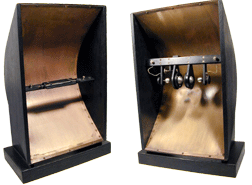| |
|
The wireless telegraph
is not difficult to understand.
The ordinary telegraph is like a very long cat.
You pull the tail in New York, and it meows in Los Angeles.
The wireless is the same, only without the cat.
- Albert Einstein |
|

Hertz Resonator |
At left is a very
rare specimen of one of the devices used in the earliest
experiments with "Hertzian waves". This model was used
for early demonstrations around the end of the 19th
century.
At about that time there was a significant problem
of interference between signals coming from different
sources, due to the increasing number of transmitting
stations. Guglielmo Marconi was the first to adopt a
tuning system of this type. It's essentially composed of a tesla type high frequency transformer, whose primary circuit
is connected to a leyden jar, forming a resonant circuit
which reduces the bandwidth of the signal to be transmitted
coming from an induction coil. The signal then goes to the
central coil (secondary circuit) whose terminals are
connected to the transmitting aerial the earth circuit, to
be sent into the space.
A similar tuning circuit,
mounted inside the receiver, ensures the reception only of
the signal coming from that transmitting station, ignoring
all other signals present in the aerial. This circuit has
been called a "JIGGER" by Marconi, and was patented in April
1900.
|
|

Parabolic Transmitter and Receiver
Utilizing Righi spark gap and Branly Coherer
I believe this is to be a replica
made in the 1920's of a very early Marconi experimental set
built in the 1890's.

Bing Coherer/Decoherer (receiver)
with Rhumkorff
Transmitter
1906

Antenna coupling coils from
Spark Gap
Transmitter
~1910 |
 
Collins Wireless
Telephone
(Inductive Model)
1909
A. Frederick Collins was one
of the earliest promoters of the of wireless telephone.
Controversy remains as to whether his devices actually
worked as promised. Both a transmitter and a receiver, the
unit above is the last known Collins Wireless telephone. It
is on display at the
American Museum of Radio in Bellingham, Wa.
Click
here to learn more about Collins and his amazing
telephone.
|

Early experimental Hertz
transmitting apparatus
~1890
For more information about Heinrich Hertz and his
discovery of radio waves, click HERE. |

Hertz resonator for detecting Hertzian
waves
~1890
This simple spark gap apparatus was the first device
ever built to detect radio waves. |

Righi detector
~1897
Professor Righi of Bologna
improved the Hertz resonator by replacing the small spark
gap with thin bands of quicksilver, as used for mirrors,
divided in half by cross lines lightly traced with a
diamond. |
|
|